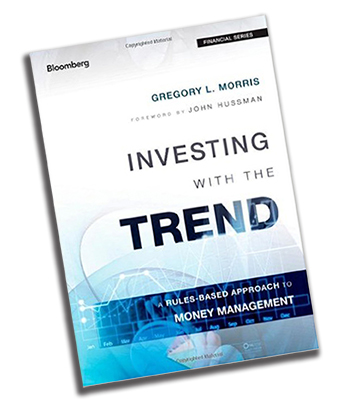The power of investing with the trend

A timeless read on understanding and implementing trend-based active investment management strategies
“Investing with the Trend,” has something to offer. In many ways, it is a compilation of Morris’ 40 years of investing experience, years of working and talking with legends in the industry, years of challenging popular financial theory, and years of trying to understand how best to profit from the financial markets.
 To provide an introduction to “Investing with the Trend,” it helps to start with the author. Morris’ professional life has taken two paths—the pilot’s seat and technical analysis. He earned his pilot’s license in 1967, graduated from The University of Texas at Austin with a degree in Aerospace Engineering, and spent the next seven years as a U.S. Navy F-4 fighter pilot. Morris also graduated from the Navy Fighter Weapons School, known as “Top Gun,” and went on to log 240 carrier landings and has flown in excess of Mach 2—twice the speed of sound. Over the course of his Navy career and subsequent years as a captain with Delta Air Lines, he logged more than 21,000 hours of flying time and “never put a scratch on an airplane.”
To provide an introduction to “Investing with the Trend,” it helps to start with the author. Morris’ professional life has taken two paths—the pilot’s seat and technical analysis. He earned his pilot’s license in 1967, graduated from The University of Texas at Austin with a degree in Aerospace Engineering, and spent the next seven years as a U.S. Navy F-4 fighter pilot. Morris also graduated from the Navy Fighter Weapons School, known as “Top Gun,” and went on to log 240 carrier landings and has flown in excess of Mach 2—twice the speed of sound. Over the course of his Navy career and subsequent years as a captain with Delta Air Lines, he logged more than 21,000 hours of flying time and “never put a scratch on an airplane.”
Managing risk was always part of the job, along with distancing personal emotions from decisions, considering the odds, and making the right decisions at the right times. When you combine that with a mathematical turn of mind, Morris’ second focus—technical analysis—comes into play. His commercial flight schedule often found Morris far from home with time for serious thinking, for asking questions, and looking for answers to mathematical challenges—foremost those from the financial markets. From 1982 until 1993, working in association with N-Squared Computing, he produced more than 15 technical analysis and charting software titles, many of which are still used today.
As he traversed the world, Morris made a point of meeting with investment professionals who interested him. In the early 1990s, he spent a considerable amount of time in Japan with Takehiro Hikita, who had translated most of the Japanese books on candlestick patterns. Morris, in turn, took an engineering approach to validate the patterns and has written extensively about their use—including his book, “Candlestick Charting Explained.” From 1996 to 2002, he was CEO of MurphyMorris Inc., a leading provider of web-based market analysis tools, education, and commentary. In 1999, he joined with three associates to start a registered investment advisory firm that later became an advisor to the MurphyMorris ETF Fund and then Stadion Money Management LLC. Morris continues to serve as a consultant to Stadion, which has more than $6 billion in assets under management.
“Investing with the Trend: A Rules-based Approach to Money Management” was published in December 2013 and brings the lessons learned over those years together in one book that walks the reader through the supporting logic for active management and Morris’ disillusionment with traditional investment approaches. Using the basic concepts and tools of active management, Morris puts forward a trend-trading approach to investing designed to be customized by the user. While the book is heavy with tables, graphs, and mathematical explanations, it is remarkably reader friendly. One has the impression of a long discussion of active investing over many cups of coffee.
Part 1: Market Fictions, Flaws, and Facts is an exceptional collection of information that can be used to explain a rules-based active approach to investing. Morris thoroughly debunks the wisdom of buy-and-hold investing and popular investment theories, provides the rationale for active management, and sets the basic parameters for a successful active management approach. “The Enemy in the Mirror” chapter stands out by going beyond the fundamental concepts of behavioral finance to look at a wide array of biases that investors bring to the markets. At the end, one has a list of additional books to read, including James Montier’s “Little Book of Behavioral Investing” (recommended as a once-a-year read) and a much greater understanding of Morris’ issues with many aspects of modern investment theory.
“I am often asked advice from young traders and investors. The consistent and most stressed thing I tell them is to learn about yourself. Understanding behavioral biases will help accomplish that.”
— author Gregory L. Morris
Part 2: Market Research introduces the reader to technical analysis, beginning Morris-style by relating the story of the first two stocks he purchased as a young Navy flyer, and held as they declined more than 75% in value. The theme is remarkably similar to the initiation of many active managers to the world of investing—resulting in the realization that avoiding steep drawdowns and not losing money is a better way to invest. From there, the book moves into trend analysis, the core of technical analysis.
In explaining the importance of trend analysis, Morris references Martin Pring’s definition that the art of technical analysis is to identify trend changes at an early stage and to maintain an investment position until the weight of evidence indicates that the trend has reversed. For Morris, proving the rationale of his explanations is essential, resulting in a chart- and graph-heavy section, but he pays it off well with a quote from Leonardo da Vinci: “He who does not know the supreme certainty of mathematics is wallowing in confusion.”
“Too much information can lead to a total disarray of investment ideas and decisions. Keep it simple, turn off the outside noise, and use a technical approach to determine which issues to buy and sell. You’ll be healthier.”
— author Gregory L. Morris
Part 3: Rules-Based Money Management begins with a review of technical indicators from price- and breadth-based indicators to cyclical market measures, relative strength, trend-capturing indicators, confirmation measures, and more. Morris takes this beyond the academic, however, by including cautionary advice learned from his mistakes over the years. For example, optimization in the wrong hands is extremely dangerous, he maintains, saying, “If you do try to optimize, then please read some good book on the downfalls of doing so.” From there the discussion moves to security ranking, selection, rules, and guidelines. Throughout his explanations, Morris provides straightforward advice on how to use and not use ranking measures and market analysis.
“A rules-based trend follower never asks the questions: Which way is the market going to go? Are we near a top, a bottom, and so on? A trend follower doesn’t need to know and shouldn’t actually care other than inherent curiosity.”
— author Gregory L. Morris
In some reviews of “Investing with the Trend,” it is the very last section, Putting it all Together: The “Dancing with the Trend” Model, that a few readers take issue with, maintaining it does not go far enough in providing the “final” answer. But as Morris sets out throughout the book, there is no one right answer, no one set of rules that overshadows all others.
“Investing with the Trend” is very much a book of tools, of operating instructions, and good advice that provides a general plan to “put it all together” in a working fashion. Morris is well aware that the financial market is a moving target, continually evolving and changing. While buy-and-hold and indexing proponents seek “the easy answers,” the value of active investment management is in the ability of the manager to adapt to the market, to look beyond the easy answers to ask, What is happening now? Are my clients’ portfolios properly positioned to minimize losses if the market turns down? Where are the opportunities for profit in the market? “Investing with the Trend” provides an excellent framework for answering those questions.
This is a book active managers and financial advisors are going to want to read over and over. At the very least, it will save the reader the 40 years it took Greg Morris to accumulate the same information the hard way.
“Risk is at the heart of Modern Portfolio Theory, the Capital Asset Pricing Model, Efficient Market Hypothesis, Random Walk, and Option Pricing Theory, but the risk they address is nonsystematic risk—often referred to as ‘diversifiable risk.’ There is a much larger piece of the risk pie called ‘systematic risk.’ This is the risk technical analysis attempts to deal with.”
— author Gregory L. Morris
The opinions expressed in this article are those of the author and do not necessarily represent the views of Proactive Advisor Magazine. These opinions are presented for educational purposes only.
 Linda Ferentchak is the president of Financial Communications Associates. Ms. Ferentchak has worked in financial industry communications since 1979 and has an extensive background in investment and money-management philosophies and strategies. She is a member of the Business Marketing Association and holds the APR accreditation from the Public Relations Society of America. Her work has received numerous awards, including the American Marketing Association’s Gold Peak award. activemanagersresource.com
Linda Ferentchak is the president of Financial Communications Associates. Ms. Ferentchak has worked in financial industry communications since 1979 and has an extensive background in investment and money-management philosophies and strategies. She is a member of the Business Marketing Association and holds the APR accreditation from the Public Relations Society of America. Her work has received numerous awards, including the American Marketing Association’s Gold Peak award. activemanagersresource.com

